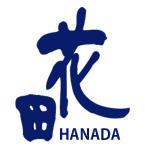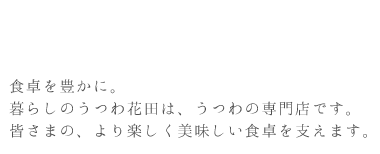種子島から始まり、デンマークへ
花田:野口さんはまず、焼き物との出会いの場となった種子島に17年、その後長崎を経て、ここ鹿児島に来られました。最近はデンマークでも定期的に制作されています。(以下花田-)
野口: 拠点はここですが、仕事場が一つである必要はありません。
今でも種子島には焼き締めを焼きに行きたいと思っています。ここに同じように窯を作るのも可能ですが、僕が向こうに一カ月くらい行ってしまったほうが早いかなと。
最近、変わってきたなと思うのは、これまで作ってきた「従来のモノ」はお客様にも安心感はあるけれど「それではないもの」も求められているなと感じるようになったことです。
-: 「今でも種子島へ」というのはあの場所への思い入れや材料が理由ですか。
野口: そうです。黄色っぽくて、鉄分の多い土です。焼き上がりが独特です。
-: ロクロを引いていても違いを感じますか。
野口: 肌理が細かいので、挽きやすいです。
元々その土しか知らなくて、当たり前に思っていましたが、他の土を触ってみて、そのことに気が付きました。久しぶりに、種子島でロクロ引くと、自分がロクロうまくなったと錯覚するくらい(笑)。
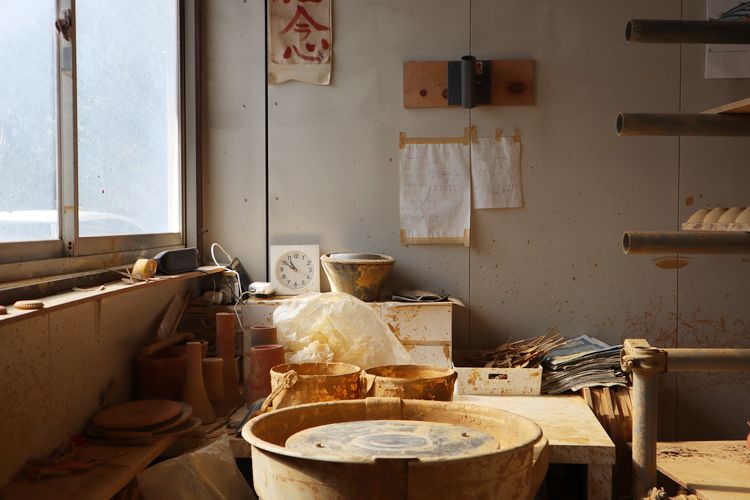
-: デンマークに行くようになったきっかけは何だったのですか?
野口: デンマークでスイッチバックキルンを作る機会をいただいて、その時に以前から気になっていたビューツさんの工房(野口さんが定期的に訪問しているところ)を訪ねたのが始まりです。
-: デンマークにはどれくらいの頻度で行かれているのですか。
野口: 多いと年3回。大体1カ月から1カ月半滞在しています。
-: デンマークのなんという町なのですか。
野口: ホーセンズという、海沿いの町です。
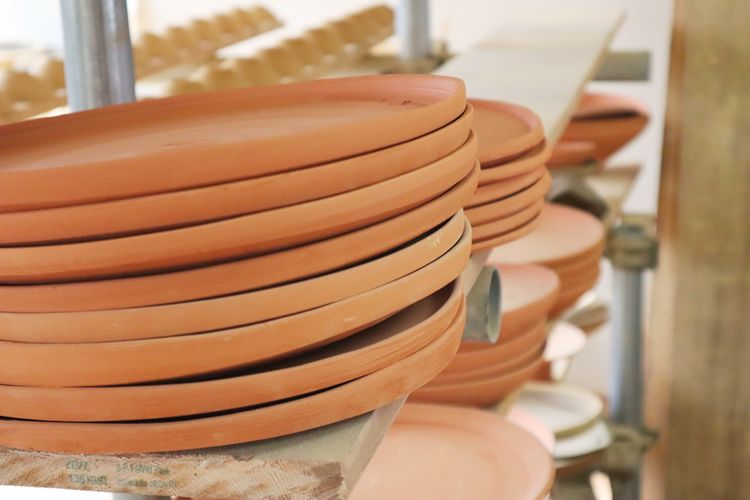
薪窯とガス窯
-: 野口さんが焼き物を始めてから25年経ちます。
野口: 最初の頃は粘土も薪も自分たちで用意していたので、粘土屋さんの存在すら知りませんでした。
窯も大きかったので、薪の準備だけで1週間から10日かかかるんです。みんなそうしているものだとばかり、思っていた(笑)。
でもまあ、その頃は、楽しかったです。
-: その頃は・・・ですね(笑)。
野口: 原点としてそれでよかったのだと思いますし、それはそれでこれからも続けていきたいです。でも一方で、違うアプローチでもモノを作っていきたいなと感じ始めています。
-: デンマークの影響でしょうか。
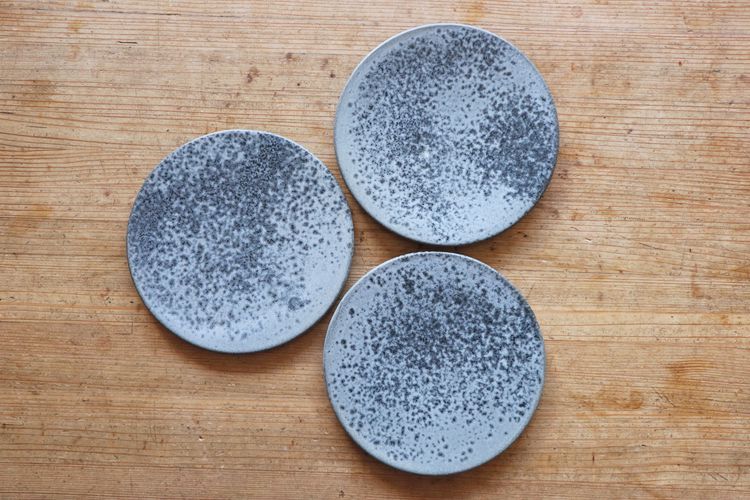
野口: はい。(実物を見せながら)これが、デンマークのビューツさん達の作ったものです。一個一個表情が違いますよね。
よく「薪窯で焼いたみたい」と言われるらしいですが、使っているのはガス窯です。しかも最新式のタッチパネル。彼らは焼くときでなく、施釉の段階で重要な仕事をしていて、釉の掛け方や順番を工夫しながら重ねることで変化を生み出しています。
日本で同じことをやろうとすると、恐らく薪窯での偶然性を期待する方法を選びますよね。日本のそういうところも僕は好きですが、デンマークの場合、このトーンの不安定さを安定して作ろうとする。焼きに全く偶然性を求めていないんですよ。
しかも、基本的に、土は1種類、釉は3種類。これは、僕が彼らの所で作ったものですが、これもやはり釉薬の重ね方が違うだけなんです。
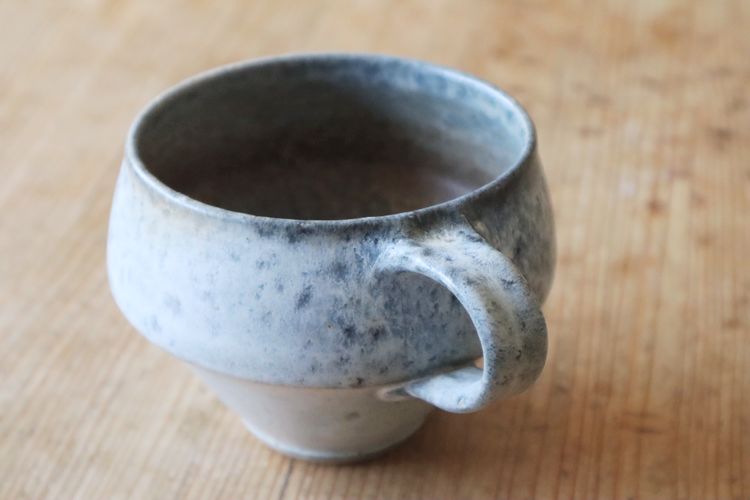
-: これ、なんとなく偶然起きたように見えます。
野口: 「薪で焼いた」と言われれば「ああそうかな」と思いそう。これを限られた手法や材料で実現している。「すげえな、この人たち・・・」って。
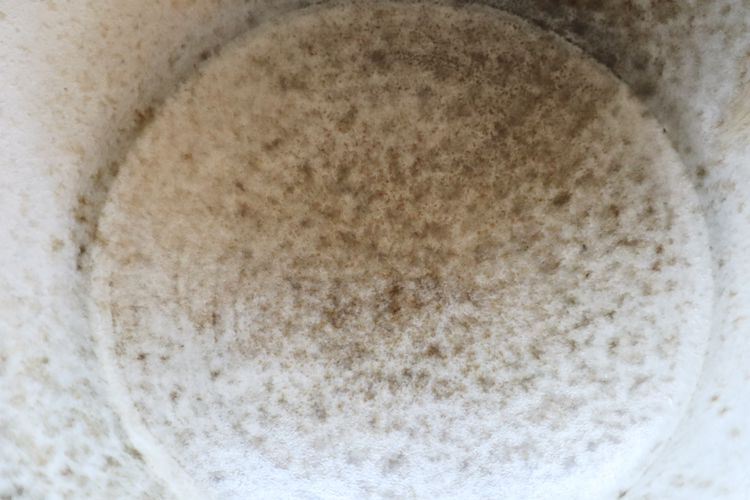
デンマークの「食器屋」
-: デンマークでの活動は良い刺激になったのですね。
野口: 彼らは予想以上に「食器屋」でした。
例えば、この皿を作る人は、本当にこれしか作らない。この形のこの大きさの平皿をずっと一人が作っている。それに、釉薬かける人はかけるだけ。ロクロ引く人はロクロ引くだけ。
ビューツ親子二人の考え方も、レストラン、シェフのためのうつわへの特化をベースにしていて、そこからぶれることはまずありません。
-: 個体差など、シェフたちにとってちょうどいい程度を実現しているのでしょうね。非常に、納得がいきます。誰が全体を仕切っているのですか。
野口: ビューツ親子の息子さんのほうのキャスパー・ビューツさんが基本的には指揮をとっていますが、雰囲気としてはみんなが自分のやれることを自主的にやっている感じです。本当に皆がフラットな感じで。
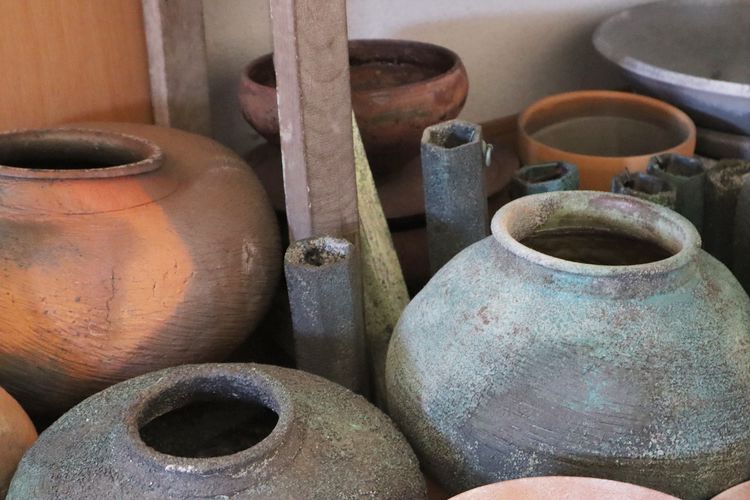
自らの仕事へ
野口: デンマークでの経験のおかげで、僕の持っている赤土と電気窯で出来ることがまだまだあることに気が付くことができました。
実際、彼らの釉薬の掛け方や焼き方を取り入れています。土も釉も違うので、最初はうまくいきませんでしたが、ようやく最近、自分の好きな状態に落とし込めるようになってきています。
-: 目指すものに違いはありますか。
野口: 満足感の質が違うような気はします。
種子島の場合は「イイの焼けた!」という感じで、デンマークは「格好よく仕上がった!」という感じです。
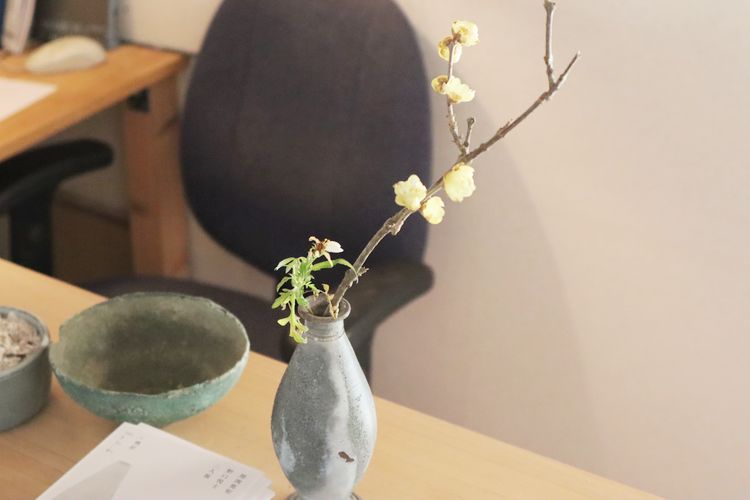
須恵器、サーフボード、中里先生・・・
-: 野口さんは世界へ目を向ける一方、物からも色々吸収し、自分のものにされていきますね。
野口: 古いものだと、弥生土器や須恵器の持つ雰囲気に魅かれます。サーフボードにもだいぶ影響を受けていると思います。
-: 大学生の頃のアルバイト先の・・・。
野口: そうです。サーフィンが好きで、学生の時サーフボードの工場でアルバイトしていた時に「サーフボードって美しいな」と思いました。
自分の仕事の中にも、サーフボード的な美しさというのは、どこか入っている気がします。
-: サーフボードって、自然の波に合わせて作るものだから、必然的に自然な曲線に行きつくのでしょうね。
野口: サーフボードはエッジがきいていないとうまくいかない。曲線は美しいですし、一方でピッとエッジがきいている。
-: まるで、今の焼き物の仕事を表現されているようですね。
野口: デンマークの仕事にも同じことを感じます。彼らも僕が作ったものに、似たようなことを感じてくれているのかなと。
-: お互いにとっての技術的な恩恵だけでなく、そういった共感があるから関係が続いているのですね。
野口: もっと言えば、中里隆先生にもそういうものを感じていました。つまり、色々な物がみんな一緒に重なってきました。
多分、そういうものが好きなんですね。
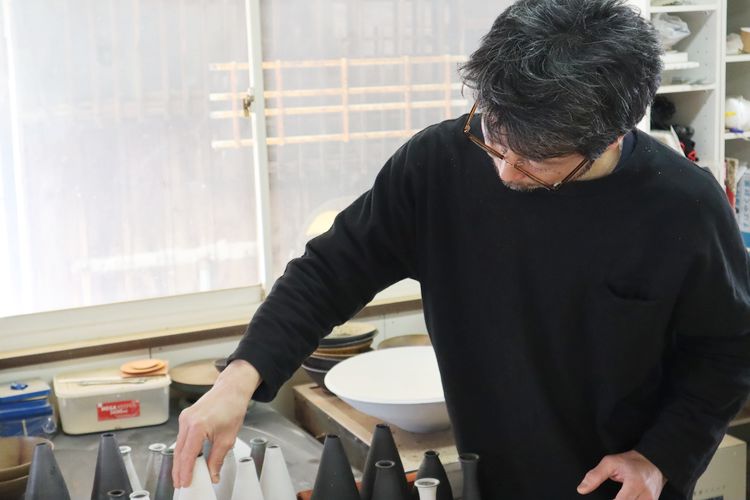
出会い
-: 今後について、考えていることはありますか。普通ならあと2-30年は焼き物を続けることになります。
野口: 元々、中里先生の焼き物をきっかけに中里先生に出会い、その仕事ぶりを見た時の衝撃から始まった陶芸です。
中里先生を始めとして、サーフボード工場の先輩たち、デンマークの人たち・・・どれも、僕にとっては大切な出会いでした。
これから25年やるとすれば、常にそういう出会いを求めていきたいと思います。それがどこで、いつ起きるのか分かりませんけども、25年もあるのなら、あと何回かそういうこともあるのかな。
-: 楽しみですね。
野口: そのためにも、積極的に色々なところに出掛けて行って、自分自身をアップデートしたり、変化させたりしていきたいです。
-: 焼き物は、その場所でしかできないものを考えがちですけど、野口さんの場合、人が軸になっていて「自分さえいれば何とかなるだろう」というのがあります。
ご自身のアップデートとなると、場所を変えるのは手っ取り早い方法だと思います。環境を変えることで、半ば強制的に更新や変化を求められるわけです。
野口: オランダでも別のプロジェクトが始まりそうだったのですが、新型コロナの影響で止まってしまいました。再開を願っています。
-: 野口さんは色々声かけられますね。
野口: まあ、呼ばれたら、僕は行きますね。どこの国だとしても(笑)。
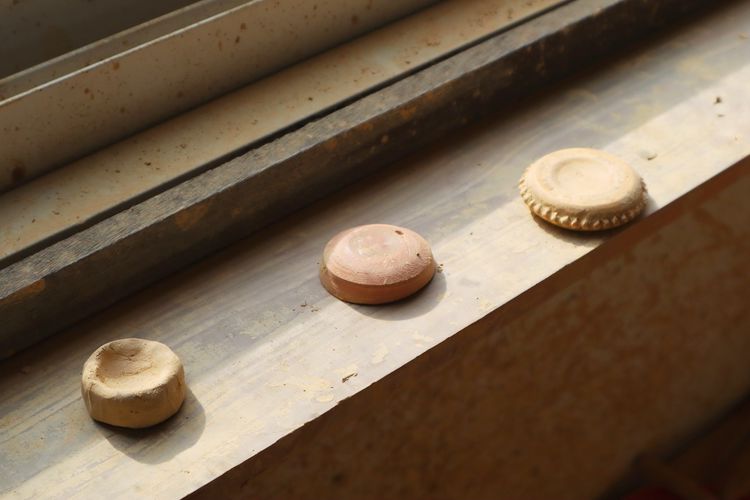
English translation / 英語表記はこちら
From Tanegashima to Denmark
Hanada: Mr. Noguchi, you spent 17 years in Tanegashima, then moved to Nagasaki, and now you’re in Kagoshima. Recently, you’ve been working regularly in Denmark as well. (The following is a conversation between Hanada and Noguchi.)
Noguchi: My base is here, but I don’t think I need just one studio. I still want to go to Tanegashima to do some bisque firing. I could build a kiln here, but I think it’s faster if I go there for about a month. Recently, I’ve started to notice a change — while the kind of work I’ve been making up until now gives customers a sense of reassurance, I also feel that people are beginning to look for something different from that.
Hanada: When you say you still want to go to Tanegashima, is that because of your attachment to the place or the materials?
Noguchi: Yes. The clay there is yellowish and rich in iron. The firing results are unique.
Hanada: Do you feel the difference even when throwing on the wheel?
Noguchi: The clay is fine-grained and smooth, so it’s easy to throw on the wheel. I originally only knew that clay, so I took it for granted. But when I tried other clays, I realized the difference. When I threw on the wheel in Tanegashima after a long time, I felt like I’d become better at it (laughs).

Hanada: What led you to start working in Denmark?
Noguchi: I had the opportunity to build a wood-fired kiln in Denmark, and during that time, I visited the studio of the Bütcher family, whom I’d been interested in for a while.
Hanada: How often do you go to Denmark?
Noguchi: Up to three times a year. I usually stay for about a month to a month and a half.
Hanada: What town in Denmark are you based in?
Noguchi: It’s a seaside town called Horsens.

Wood-fired Kiln vs. Gas Kiln
Hanada: It’s been 25 years since you started pottery.
Noguchi: In the beginning, we prepared our own clay and firewood, so I didn’t even know about clay suppliers. The kiln was large, so preparing firewood alone took about a week to ten days. I thought everyone did it that way (laughs). But well, it was fun back then.
Hanada: That was then… (laughs).
Noguchi: I think it was good as a starting point, and I want to continue that. But on the other hand, I’ve started to feel that I want to make things through a different approach.
Hanada: Is that influence from Denmark?

Noguchi: Yes. (Showing an example) This is something made by the Bütcher family in Denmark. Each piece has a different expression. They’re often said to be “like wood-fired pieces,” but they use a gas kiln. And it’s the latest model with a touch panel. They focus on glazing techniques, layering glazes in a specific order to create variations. If we tried to do the same thing in Japan, we’d probably choose methods that rely on the randomness of a wood-fired kiln. I like that aspect of Japan, but in Denmark, they aim to consistently achieve this tone. They don’t seek any randomness in the firing process. Also, they basically use one type of clay and three types of glaze. This piece I made there is also just a result of different glazing techniques.

Hanada: This looks like it happened by chance.
Noguchi: If you were told it was “wood-fired,” you’d probably think, “Oh, I see.” But it’s achieved with limited methods and materials. Then I thought “Wow, these people are amazing…”

Denmark’s “Tableware Maker”
Hanada: Your activities in Denmark have been a good stimulus, haven’t they?
Noguchi: They were more of a “tableware maker” than I expected. For example, the person who makes this plate only makes this specific size and shape. The person who applies the glaze only does that. The person who throws on the wheel only throws. The Bütcher father and son have a concept focused on tableware for restaurants and chefs, and they don’t deviate from that.
Hanada: They probably achieve just the right amount of variation for the chefs. It makes perfect sense. Who oversees the whole process?
Noguchi: The son, Kasper Bütcher, basically takes the lead, but the atmosphere is such that everyone does what they can do voluntarily. It’s really a flat structure.

Back to His Own Work
Noguchi: Thanks to my experience in Denmark, I’ve realized that there’s still a lot I can do with my red clay and electric kiln. I’ve actually incorporated their glazing and firing techniques. Since the clay and glazes are different, it didn’t go well at first, but recently, I’ve been able to bring it closer to the state I like.
Hanada: Is there a difference in what you’re aiming for?
Noguchi: I feel the quality of satisfaction is different. In Tanegashima, it’s like “I made a good one!” In Denmark, it’s like “It turned out stylish!”

Sue Ware, Surfboards, and Mr. Nakazato…
Hanada: While looking to the world, you also absorb various influences from objects and make them your own.
Noguchi: I’m attracted to the atmosphere of Yayoi pottery and Sue ware. I think I’ve also been influenced by surfboards.
Hanada: From your part-time job at a surfboard factory during university days…
Noguchi: Yes. I liked surfing, and when I worked part-time at a surfboard factory during my student days, I thought, “Surfboards are beautiful.” I feel that the beauty of surfboards is somehow present in my work.
Hanada: Surfboards are made to match the natural waves, so they inevitably lead to natural curves.
Noguchi: Yes, Surfboards need to have sharp edges to work well. The curves are beautiful, and on the other hand, they have sharp edges.
Hanada: It’s like you’re expressing your current pottery work.
Noguchi: I feel the same in my work in Denmark. I think they might feel something similar in the pieces I’ve made.
Hanada: It’s not just technical benefits but also mutual empathy that keeps the relationship going.
Noguchi: To put it more, I also felt that way with Mr. Takashi Nakazato. In other words, various things have overlapped for me. I think I like those kinds of things.

Encounters
Hanada: Regarding the future, what are your thoughts? Normally, you would continue pottery for another 20–30 years.
Noguchi: My journey in ceramics began with meeting Mr. Nakazato, inspired by his work. His craftsmanship had a big impact on me. From Mr. Nakazato, my seniors at the surfboard factory, to the people in Denmark—each encounter has been significant. If I continue for another 25 years, I want to constantly seek such encounters. I don’t know where or when they will happen, but in 25 years, there will probably be a few more.
Hanada: That sounds exciting.
Noguchi: To make that happen, I want to actively visit various places, update myself, and embrace change.
Hanada: Pottery often depends on the place, but in your case, the person is central—you just need to be there. Changing locations is a quick way to update and transform yourself, forcing change through the environment.
Noguchi: There was a separate project planned in the Netherlands, but it was halted due to COVID-19. I hope it will resume.
Hanada: You get invited to various places, don’t you?
Noguchi: Well, if I’m invited, I’ll go anywhere (laughs).





